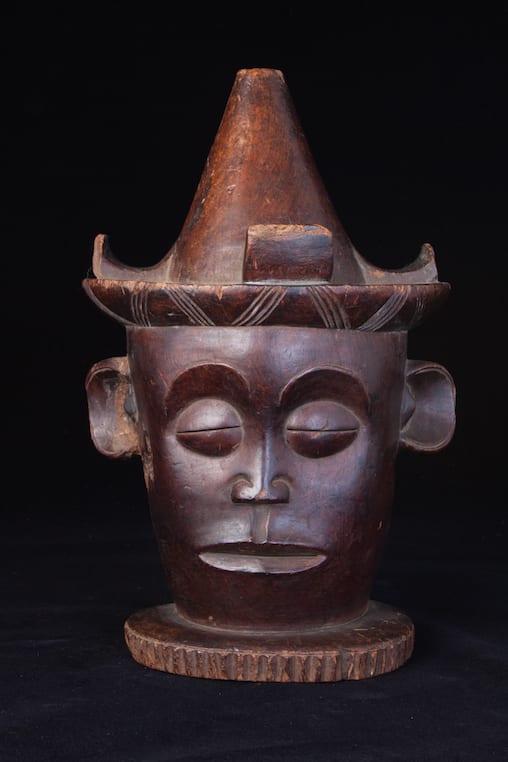Chokwe Wooden Cihongo Mask, 20th Century CE
Wood
12
PF.3990 (LSO)
This austere and serene mask was made by the Tchokwe (or Chokwe) of Angola. It is an unusual variant of their masking traditions. It constitutes a rounded, decorated-edge base, so...
This austere and serene mask was made by the Tchokwe (or Chokwe) of Angola. It is an unusual variant of their masking traditions. It constitutes a rounded, decorated-edge base, so that it stands, with a wide neck, flaring to a long, somewhat lugubrious face. The rendering of the eyes (slit coffee-bean format) the snub nose, large ears and the wide mouth are all traditionally Tchokwe, but the shape of the face, the tall, ornate hat with a central cone and four flourishes and the absence of a motif on the central forehead are not as typical. The mask opens posteriorly, but seems impractical for usage as it is very small internally. The patination is superb, with some evidence of usage and wear.
The Tchokwe are distributed across Angola, the DR of Congo and Zambia, and can trace their ancestry to the Lunda Empire of the 15th, when a mass-migration occurred out of Lunda/Luba territory. The resulting kingdoms – including the Tchokwe, Luena, Songo, Ovimbundu and Imbagala – were all closely allied until the mid 19th century when the Tchokwe, following a great famine, migrated south. Their art and culture is thus distinctive compared to that of the other Lunda-descended tribes.
Society is governed by a God-King (Mwana Ngana), under whom men’s (Mugonge) and women’s (Ukule) societies control age classes and ensure social harmony. This system has resulted in a series of masks that are designed to defuse social tensions, celebrate important events (i.e. circumcisions), impose judiciary powers and promote fertility, health and well-being. The main mask forms for which the Tchokwe are known are the male Cihongo mask – which symbolises wealth, power and judicial authority – and the female Pwo mask, which is an embodiment of idealised femininity. The current piece is an exceptional example of the former. The two “sexes” were sometimes danced together at ceremonies to ensure fertility and prosperity.
The possession of ornate headwear was one of many ways in which African elites demonstrate their power. Others include scarifications, expensive accessories (i.e. jewellery), advanced age (in gerontocracies) and the possession of objects such as stools or horses. Given the manner in which this piece is carved, and the extent to which it has obviously been used, it must have been a very important object which signalled the social status of the owner, or perhaps wearer. This is a beautiful piece of African art.
The Tchokwe are distributed across Angola, the DR of Congo and Zambia, and can trace their ancestry to the Lunda Empire of the 15th, when a mass-migration occurred out of Lunda/Luba territory. The resulting kingdoms – including the Tchokwe, Luena, Songo, Ovimbundu and Imbagala – were all closely allied until the mid 19th century when the Tchokwe, following a great famine, migrated south. Their art and culture is thus distinctive compared to that of the other Lunda-descended tribes.
Society is governed by a God-King (Mwana Ngana), under whom men’s (Mugonge) and women’s (Ukule) societies control age classes and ensure social harmony. This system has resulted in a series of masks that are designed to defuse social tensions, celebrate important events (i.e. circumcisions), impose judiciary powers and promote fertility, health and well-being. The main mask forms for which the Tchokwe are known are the male Cihongo mask – which symbolises wealth, power and judicial authority – and the female Pwo mask, which is an embodiment of idealised femininity. The current piece is an exceptional example of the former. The two “sexes” were sometimes danced together at ceremonies to ensure fertility and prosperity.
The possession of ornate headwear was one of many ways in which African elites demonstrate their power. Others include scarifications, expensive accessories (i.e. jewellery), advanced age (in gerontocracies) and the possession of objects such as stools or horses. Given the manner in which this piece is carved, and the extent to which it has obviously been used, it must have been a very important object which signalled the social status of the owner, or perhaps wearer. This is a beautiful piece of African art.
Literature
V19
